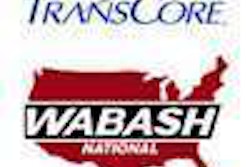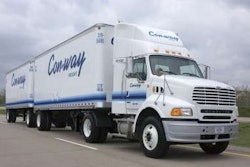Technology helps automate fuel buying and ensure driver compliance with fleet preferences
Although diesel prices have fallen dramatically since last summer, they continue to vary widely across state lines and even street corners. Purchasing fuel at the least cost, each day, is a challenge for one vehicle, let alone an entire fleet. Fuel prices, truck routes, fuel levels, tank capacity and the fuel economy of each vehicle must be considered. You also can’t ignore the impact of fuel taxes, fuel network discounts and drivers’ truckstop preferences.
For more than a decade, fleets have used fuel optimization software to solve this problem and save anywhere from 2 to 12 cents per gallon from their fuel bill. Fleets can set up these systems to translate fuel discounts, networks and other money-saving strategies already in place into actual purchases at the pump. Fleets can optimize their fuel price savings by delegating purchasing decisions fully to the software, but ultimately the ability to ensure drivers will follow those choices determines how much the fleet really saves.
“The value and luxury of high compliance is that we can open up the fuel optimizer to as many truckstops as possible on our network,” says Murry Fitzer, chief executive officer of Florilli Transportation, a 250-truck refrigerated carrier based in West Liberty, Iowa. “That really is the whole point and value of optimization.”
Automated fuel plans
To maximize efficiency, many fleets that have fuel optimization software use it as part of an integrated system for dispatching and routing their drivers.
Many companies have a standard protocol drivers use to request their next trip assignment. When a driver is available for dispatch, he sends a “macro” or standard message from an onboard computer. The computer prompts the driver to enter his current fuel level. The fuel level and vehicle location are sent to a server via wireless communications. The fuel optimization software enters this data and data from other sources into an algorithm that produces a fuel and route plan.
After solving the equation, the system generates a text message to the driver communicating trip details that include load assignments, fuel purchases and routes. When integrated with dispatch and mobile communications systems in this manner, fuel optimization software inherently improves driver compliance, Fitzer says.
Driver compliance is about 97 percent at Florilli Transportation, which Fitzer credits to his driver managers monitoring weekly reports and communicating with drivers about the importance of compliance. Driver managers receive a small financial incentive if their drivers achieve above a certain level.
Florilli uses IDSC ExpertFuel from TMW Systems, which has reports that compare each driver’s actual fuel purchases to the recommendation so that fleets can quantify lost fuel savings by driver. Showing drivers the actual amount their noncompliance costs the company is an effective way to improve compliance, says David McKinney, vice president of professional services for TMW Systems.
“We’ve found that dialogue (with drivers) via telephone or through satellite communication to be the most effective tool,” Fitzer says. “Compliance is a function of working both ends of the spectrum – recognizing and acknowledging those who are 100 percent compliant, and addressing those not achieving compliance.”
Florilli purchases the majority of its fuel through a single truckstop chain. On occasion, the optimizer finds fuel cheaper than its existing fuel discounts in the network, but Fitzer says the company wouldn’t be able to take advantage of opportunities when they arise if its compliance were not so high. “If you do not have high compliance, you are forced to choke it down to a tight network of truckstops,” he says.
Manhattan Associates says all of its customers have the company’s Fuel&Route fuel optimization software integrated with their dispatch and mobile communications systems. The company says it provides full automation to achieve high driver compliance, but recommends that clients initially set up Fuel&Route to send drivers only to fuel locations in their existing network. “Whatever a company has in place, we will mirror on fuel optimization,” says Mike Glasgow, carrier management account executive.
Besides restricting the software to locations familiar to drivers, fleets also can adjust parameters to improve driver compliance with the software’s recommendations. For example, raising the minimum number of gallons to be added at each fueling or the minimum fuel level in transit will help some drivers feel more comfortable with the recommendations, Glasgow says.
Optimization for all sizes
Fully integrated fuel and routing software can maximize efficiency, but even fleets without a full spectrum of technology tools can utilize fuel optimization.
For the past five years, ProMiles has offered fuel optimization for no extra cost in its ProMiles XF truck mileage and routing package for both online and client-installed versions. As with all fuel optimization software, ProMiles calculates routes by using current fuel price information through direct feeds of fuel transactions from vendors of fuel purchasing cards.
The CD version of ProMiles XF offers an optional fuel management application with additional features, such as reports that reconcile actual purchases with preplanned purchases to monitor driver compliance, says Chris Lee, marketing director.
In-cab navigation brings another option to the table for low-cost fuel optimization. The latest navigation systems use two-way communications between the office and vehicle to provide drivers with current fuel prices at locations along their route, along with other points-of-interest information such as truck parking.
NaviGo, an in-cab navigation service by Maptuit, uses a hybrid combination of onboard and server-based technologies to produce routes for commercial trucks. Maptuit recently added a Find Fuel Now feature to NaviGo, says Luke Wachtel, executive vice president of sales.
Maptuit’s servers constantly query fuel prices along the truck’s corridor. When drivers select Find Fuel Now, the best fuel prices along the route are sent to NaviGo, Wachtel says. Fleets might set up the software to limit drivers’ choices to see only the top three locations on the route, or only fuel stops that are within their network.
Maptuit also offers a full fuel optimization product that is integrated with dispatch and mobile communications systems. However, Wachtel says some fleets haven’t enjoyed good compliance rates with full fuel planning because some drivers don’t want to be told to stop for fuel at a specific location.
“Find Fuel Now was created to work either for small fleets that haven’t even considered fuel planning and optimization, or for the fleet that believes that always providing the top three choices, which a driver may select from 80 percent of the time, is better than providing the optimal choice that drivers may end up only using 30 percent of the time,” Wachtel says.
Forcing compliance
Giving drivers more choices might help to improve compliance in some cases, but technology also can be used to mandate compliance.
Maptuit and a fuel card provider are developing an integrated fuel purchasing application for a common customer, with plans to offer the application to the entire industry. When completed, fleets will be able to lock down fuel purchases automatically to the stations selected by the fuel optimizer, Wachtel says.
To do this, a driver would send a message from an onboard computer to the dispatch system to request a route. The dispatch system would make a “call” to Maptuit servers to generate a route and fuel plan. This information would be sent to the fuel card provider’s server. In turn, the fuel card provider would limit the driver’s fueling to specified stops, for a certain period of time, and for specific gallon amounts.
The application can ensure drivers use safer, shorter routes and fuel only at planned fuel stops, Wachtel says.
Manhattan Associates already has added such a feature to Fuel&Route, and more of its customers are going in that direction, Glasgow says. “It not only makes compliance a non-issue, it virtually eliminates fuel theft,” he says. Fuel&Route can be set up to send managers immediate exception alerts if the level of fuel the driver reports in his tanks does not match up with what it should be.
To catch exceptions, the software can capture real-time mpg by interfacing with onboard computing systems that monitor engine data. When a driver ends a trip, the software captures an ending fuel level based on beginning fuel level, the fuel pumped at the fuel stop, and the vehicle’s real-time mpg.
As with other integrated fuel optimization systems, drivers are prompted to enter their current fuel level at the time they request their next dispatch through the onboard computer. Any discrepancies in the data entered by drivers will catch up with them eventually, Glasgow says.
Regardless of what level of controls you need to maximize driver compliance and reduce fuel theft, fuel optimization will prevent a situation of having a driver fill up at one stop only to find a less expensive stop a few miles down the road.
Optimization options
Manhattan Associates (www.manh.com) has provided fuel optimization since 1996. Its Fuel&Route product currently is offered in a client-server installation. Generally, carriers that use the product operate more than 100 trucks, says Mike Glasgow, carrier management account executive. Installation of Fuel&Route in a fully integrated system with dispatch and mobile communications is a fast process and typically is complete in 30 to 45 days, he says.
ProMiles (www.promiles.com) offers fuel optimization at no additional cost for the CD and online software versions of its ProMiles XF truck routing and mileage software. About 50 percent of ProMiles customers are using fuel optimization, says Chris Lee, marketing director. ProMiles also offers a fuel management application as an add-on product for customers that use its CD-based version.
TMW Systems (www.tmwsystems.com) offers two fuel optimization products: FuelAdvice.com and IDSC ExpertFuel. Users of the Web-based FuelAdvice.com pay a monthly price, per truck, to get optimal fuel and route plans. IDSC ExpertFuel is a client-server product that is fully integrated with dispatch and enterprise management systems.
Rand McNally (www.randmcnally.com/trucking) offers FuelAdvice.com as an integrated product in its IntelliRoute truck routing, mapping and mileage software. The IntelliRoute Fuel optimization package provides carriers with daily fuel location pricing information, optimal fuel trip planning and fuel query services, the company says.
ALK (www.alk.com) offers FuelAdvice.com as an option in its PC Miler mileage and routing software. TMW Systems recently integrated ExpertFuel with the toll information in PC Miler. “It’s a real positive for carriers that run through the Northeast,” says David McKinney, vice president of professional services. Toll information allows the user to specify mileage and time costs in ExpertFuel, and compare the cost of using a toll avoidance route, including fuel, with the cost of using a regular practical route, McKinney says.
Maptuit (www.maptuit.com) offers fuel optimization as part of a monthly per-truck rate for end-to-end routing and fuel optimization. Currently, about 80,000 drivers use Maptuit’s FleetNav directions product, and about 9,000 drivers use its NaviGo in-cab navigation system. The company recently added a Find Fuel Now feature to NaviGo for drivers to instantly locate the cheapest fuel prices along their current route.
Prophesy Software (www.mile.com) markets FuelLogic, which the company says is priced at a fraction of the cost of competitors. Prophesy also offers a full suite of dispatch, mileage and routing software. FuelLogic is designed to work with other systems as well, as there is a software development kit in the form of a .dll to allow third-party applications to access it, the company says.













